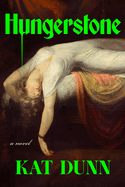
British fantasy novelist Kat Dunn crafts a sensuous, bloodthirsty delight in Hungerstone, a twist on the classic vampire tale Carmilla, set during the Industrial Revolution.
Lenore works hard at being a good wife to the handsome and wealthy steel tycoon Henry. This includes staying collected and well-kept, and never asking too many questions, even as he becomes increasingly cold and secretive. But on the way from London to their countryside estate, a carriage accident throws the enigmatic and alluring Carmilla into their paths. As Lenore's household nurses Carmilla back to health, Lenore comes to recognize the woman as a vital, manipulative creature. As Carmilla awakens a new rage and hunger inside Lenore, local girls begin dying. And soon, Lenore, too, begins developing a taste for blood.
Dunn excels at capturing the classic gothic atmosphere of her setting. Through thick drapes and misty moorlands, Lenore's first-person voice, which starts strained with care and reserve, becomes increasingly untethered. While Carmilla has her own appeal, it is Lenore and her unraveling internal monologue that really seduce readers. Her raw desire and ferocity that ultimately burst through feel more like a relief than a sign of devastation.
Dunn isn't shy, either, about digging into the dual gore and heated sexuality underlying Lenore's world. After an accident at Henry's factory, for example, one worker is left with a piece of machinery "wedged under his cheekbone, and his tongue laps at the blood filling his throat." In this truly disturbing rendering of violence, it becomes clear that Henry's world of industry and capitalist ambition is the true horror story, a nightmare of "blood and metal merging." --Alice Martin, freelance writer and editor

